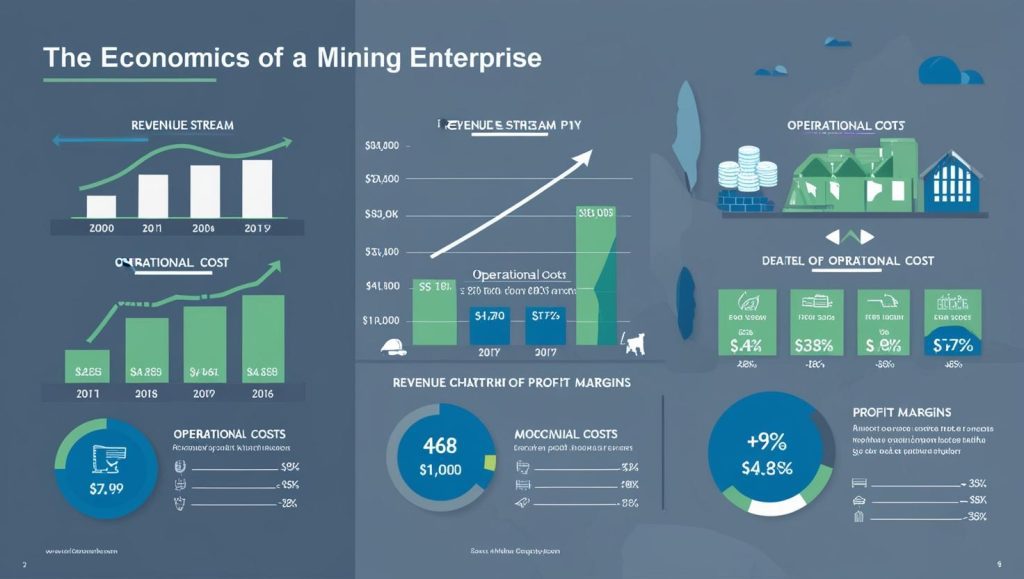Introduction
The Economics Of Mining Enterprise Homework Help is a crucial subject in mining engineering, business, and resource management. Mining enterprises play a significant role in national economies by providing essential raw materials, creating jobs, and fostering technological advancements. This blog offers a comprehensive guide to the economic aspects of mining enterprises, covering cost structures, investment decisions, profitability, and sustainability. Whether you are a student seeking homework help or a professional looking for insights, this guide will provide valuable knowledge.

Understanding Mining Economics
Mining economics involves analyzing the costs, revenues, and profitability of extracting and processing mineral resources. A mining enterprise must balance economic feasibility with environmental and social responsibilities to remain sustainable.
Key Economic Factors in Mining
- Capital Investment: Mining projects require substantial upfront investment in exploration, equipment, and infrastructure.
- Operational Costs: Includes labor, energy, equipment maintenance, and environmental compliance costs.
- Market Demand and Prices: The profitability of mining depends on fluctuating commodity prices and market demand.
- Government Regulations and Taxes: Mining enterprises must comply with tax laws, environmental regulations, and labor policies.
- Technological Advancements: Automation and AI-driven exploration can enhance efficiency and reduce costs.
Cost Structures in Mining Enterprises
Mining enterprises incur various costs throughout their operations. These costs can be categorized into:
1. Exploration and Development Costs
Before mining begins, companies invest in geological surveys, drilling, and feasibility studies. These costs determine whether a deposit is worth developing.
2. Capital Expenditures (CAPEX)
CAPEX includes spending on heavy machinery, infrastructure, and mine development. These investments are essential for long-term mining operations.
3. Operating Expenditures (OPEX)
OPEX covers day-to-day expenses such as labor, fuel, transportation, and environmental management. Efficient cost management is key to maximizing profitability.
4. Environmental and Social Costs
Mining enterprises must allocate funds for land rehabilitation, pollution control, and community development programs to ensure sustainable operations.
Investment and Profitability in Mining Enterprises
1. Risk Assessment in Mining Investments
Mining investments involve high risks due to geological uncertainties, fluctuating commodity prices, and regulatory challenges. Investors analyze factors such as:
- Resource Estimates: The quantity and quality of the mineral deposit.
- Market Conditions: Global supply and demand for minerals.
- Regulatory Risks: Compliance with environmental laws and government policies.
2. Return on Investment (ROI) in Mining
Profitability is measured using financial metrics like:
- Net Present Value (NPV): The value of future cash flows from a mining project.
- Internal Rate of Return (IRR): A measure of the project’s profitability.
- Break-even Analysis: Identifying the point where revenue covers all costs.
Sustainable Mining Economics
Sustainable mining focuses on balancing economic growth with environmental protection and social responsibility. Key strategies include:
1. Eco-Friendly Mining Practices
- Energy-Efficient Technologies: Using renewable energy sources to power mining operations.
- Waste Reduction: Implementing recycling programs for mining waste.
- Water Conservation: Reducing water usage in mineral processing.
2. Corporate Social Responsibility (CSR) in Mining
Mining enterprises invest in community development programs, including education, healthcare, and local employment opportunities.
3. Government Policies and Incentives
Governments offer incentives like tax breaks and subsidies to encourage sustainable mining practices. Policies also regulate environmental impact assessments (EIAs) and mine rehabilitation programs.
The Future of Mining Economics
The mining industry is evolving with advancements in automation, digitalization, and sustainability initiatives. Future trends include:
- AI and Data Analytics: Enhancing decision-making in exploration and resource management.
- Electric Vehicles (EVs) in Mining: Reducing carbon emissions in mining transportation.
- Circular Economy Approaches: Promoting the reuse and recycling of mining by-products.
Conclusion
Understanding the Economics Of Mining Enterprise Homework Help is essential for students and professionals in the mining sector. Managing costs, assessing risks, and implementing sustainable practices are crucial for the long-term success of mining enterprises. As the industry advances with technology and environmental regulations, mining enterprises must adapt to remain competitive and responsible.
For more insights into mining economics and sustainability, visit International Council on Mining & Metals (ICMM) or World Bank Mining Database.


